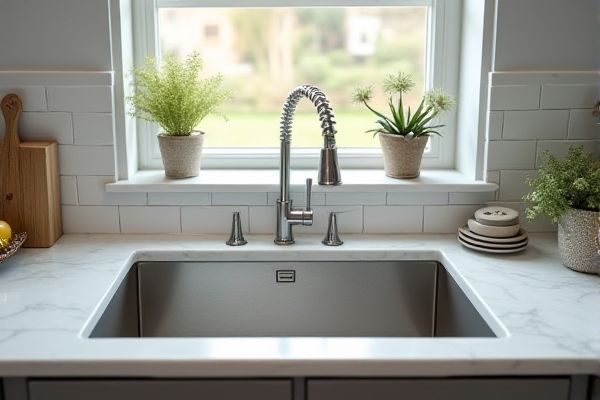
Undermount sinks offer a sleek, seamless look by being installed beneath the countertop, making cleaning easier and enhancing countertop space, while drop-in sinks rest on the countertop with a visible rim, allowing for easier installation and replacement. Discover which sink style suits Your kitchen's functionality and design by reading the rest of the article.
Table of Comparison
| Feature | Undermount Sink | Drop-in Sink |
|---|---|---|
| Installation | Mounted under the countertop | Placed into a pre-cut hole with rim resting on countertop |
| Appearance | Sleek, seamless look with exposed countertop edge | Visible rim, traditional look |
| Cleaning | Easy to wipe crumbs directly into sink | Rim can trap debris, harder to clean |
| Countertop Compatibility | Requires solid surface countertops like granite or quartz | Works with most countertop materials |
| Cost | Higher installation cost | Lower installation cost |
| Durability & Maintenance | Less prone to leaks; requires professional installation | Easy to install; rim can be prone to grime buildup |
Introduction to Undermount and Drop-In Sinks
Undermount sinks are installed beneath the countertop, creating a seamless look and making countertop cleaning easier by allowing debris to be swept directly into the sink. Drop-in sinks, also known as top-mount sinks, fit into a pre-cut hole with a visible rim resting on the countertop, offering simpler installation and compatibility with a variety of countertop materials. Choosing between undermount and drop-in sinks depends on your kitchen design preferences, maintenance habits, and countertop type.
Design Differences: Undermount vs Drop-In Sinks
Undermount sinks are installed beneath the countertop, creating a seamless and sleek appearance that emphasizes countertop material like granite or quartz, while drop-in sinks rest on the countertop with a visible rim, allowing for easier installation and replacement. The design differences impact not only aesthetics but also cleaning and maintenance; undermount sinks enable you to wipe crumbs and spills directly into the sink without obstruction, whereas drop-in sinks may collect debris along the rim edge. Your choice between undermount and drop-in sinks should consider both the countertop material and your preference for a clean, modern look versus practicality and installation simplicity.
Installation Process Comparison
Undermount sinks require precise countertop cutting and secure mounting brackets beneath the countertop for a seamless, flush appearance, making installation more complex and often needing professional expertise. Drop-in sinks, on the other hand, are easier to install because they simply fit into a pre-cut hole with a rim resting on the countertop surface, allowing for quicker and more DIY-friendly installation. Your choice affects installation time and skill level, with undermount sinks favored for aesthetics and drop-in sinks for convenience.
Cost Analysis: Undermount vs Drop-In Sinks
Undermount sinks typically cost more due to complex installation and the need for durable countertops like granite or quartz, whereas drop-in sinks are generally more budget-friendly and easier to install on a variety of countertop materials. Maintenance expenses for undermount sinks can be higher since they require professional sealing to prevent water damage, while drop-in sinks often have silicone seals that are simpler and cheaper to replace. Overall, homeowners should weigh initial investment against long-term upkeep costs when deciding between undermount and drop-in sink options.
Cleaning and Maintenance Factors
Undermount sinks offer easier countertop cleaning since debris can be wiped directly into the sink without getting caught on the rim, reducing buildup and bacteria growth. Drop-in sinks feature a raised rim that can trap dirt and grime, requiring more frequent and detailed cleaning to maintain hygiene. Your choice impacts maintenance time and effort, with undermount designs generally providing a smoother, more sanitary cleaning experience.
Durability and Longevity
Undermount sinks offer superior durability by being securely fastened beneath the countertop, reducing the risk of chipping or damage along the edges and providing a seamless surface that resists water damage. Drop-in sinks, although easier to install, have exposed edges that are more prone to wear, making them less durable over time compared to undermount models. Choosing an undermount sink can enhance your kitchen's longevity, especially when paired with solid surface countertops like granite or quartz.
Aesthetic Appeal and Kitchen Style
Undermount sinks provide a sleek, seamless look that complements modern and contemporary kitchen styles by allowing the countertop to flow uninterrupted to the sink edge. Drop-in sinks, with their visible rim, offer a traditional or casual aesthetic and are compatible with various countertop materials, making them ideal for transitional kitchens. Your choice impacts the kitchen's visual continuity and overall design, with undermount sinks enhancing minimalism and drop-in models adding classic charm.
Countertop Compatibility Considerations
Undermount sinks require solid, non-porous countertops such as granite, quartz, or solid surface materials to ensure secure attachment and prevent water damage beneath the sink. Drop-in sinks offer greater versatility with various countertop types, including laminate and tile, since their rim rests above the countertop, providing easier installation and maintenance. Your choice between undermount and drop-in sinks should consider the durability and material compatibility of your countertop to optimize both functionality and aesthetic appeal.
Pros and Cons: Undermount Sink
An undermount sink offers a sleek, seamless look by being installed beneath the countertop, making countertop cleaning easier without edges to catch debris. The primary advantage is its modern aesthetic and maximized countertop space, but it requires solid surface materials like granite or quartz for secure installation, and can be more challenging and costly to install compared to drop-in sinks. You should consider that undermount sinks also demand careful sealing to prevent water damage and may involve higher maintenance due to potential leaks.
Pros and Cons: Drop-In Sink
Drop-in sinks offer easy installation with a rim that sits above the countertop, making replacement or maintenance straightforward and less time-consuming. However, their exposed edges can accumulate grime and be harder to clean, while the raised lip may interrupt your countertop's seamless look. You benefit from durable, versatile designs suitable for most countertop materials but trade off some aesthetic appeal and potential for water seepage around the edges.
 homyna.com
homyna.com